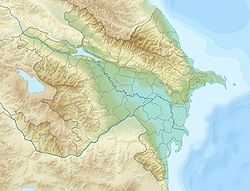1139 Ganja earthquake
 | |
| Local date | 30 September 1139 |
|---|---|
| Magnitude | 7.7 Ms[1] ~7.0 Mw[2] |
| Depth | 23 km[1] |
| Epicenter | 40°18′N 46°12′E / 40.3°N 46.2°ECoordinates: 40°18′N 46°12′E / 40.3°N 46.2°E[1] |
| Areas affected | Ganja, Seljuk Empire (present-day Azerbaijan) |
| Max. intensity | IX (Violent) or XI (Extreme) |
| Casualties | 200,000–300,000 |
The 1139 Ganja earthquake is one of the worst seismic events in history. It affected the Seljuk Empire and Kingdom of Georgia; modern-day Azerbaijan and Georgia. The earthquake had an estimated moment magnitude of 7.0 or greater and 7.7 on the surface wave magnitude scale.[2] A maximum intensity of IX (Violent) to XI (Extreme) on the Mercalli intensity scale was assigned to this earthquake.[3] The strong shaking triggered massive landslides off the sides of mountains and canyons in the Caucasus Mountains region. Parts of Kapaz Mount collapsed, with the resulting landslide blocking the Kürəkçay River, forming the lake Göygöl.[4] It was also perceived as far as Aleppo where the felt intensity was II. The estimated death toll from this earthquake is somewhere between 230,000 and 300,000 making it one of the deadliest earthquakes in history.[5] The death toll remains controversial with some authors stating that it is an exaggeration considering the population of the area at the time of the disaster,[6] or that this was a conflation with the 1138 Aleppo and 1137 Jazira earthquakes.[7]
Mkhitar Gosh, an Armenian scholar and writer, quoted Job 9:6 and Psalm 103:32 from the Holy Bible to describe the earthquake.[8] He described tremendous damage in the P'ar'isos and Xach'e'n districts of Syunik. The city of Ganzak also suffered devastation, leaving many of the townspeople buried under ruins. Many structures including monasteries and churches castles and villages in the mountainous region were totally destroyed. The number of people who died in the mountains is not known, described as "incalculable".[9]
See also[]
- List of earthquakes
- List of historical earthquakes
- List of earthquakes in Azerbaijan
References[]
- ^ a b c Ulomov, V.I.; Medvedeva, N.S. (2014). "Специализированный каталог землетрясений для задач общего сейсмического районирования территории Российской Федерации" [Specialized catalog of earthquakes for the purpose of general seismic zoning of the territory of the Russian Federation] (PDF). O.Y. Smidt Institute of Physics of the Earth, Russian Academy of Sciences.
- ^ a b Musson R.M.W. (2014). Great Earthquakes. In: Gupta H.K. (eds) Encyclopedia of Solid Earth Geophysics. Encyclopedia of Earth Sciences Series. Netherlands: Springer, Dordrecht. doi:10.1007/978-90-481-8702-7_7. ISBN 978-90-481-8702-7. Retrieved 23 June 2021.
- ^ Guidoboni, E.; Ferrari, G.; Comastria., A.; Tarabusi, G.; Sgattoni, G.; Valensise, G. (2018). "Catalogue of Strong Earthquakes in Italy 461 B.C. - 1997 and Mediterranean Area 760 B.C. - 1500". Istituto Nazionale di Geofisica e Vulcanologia (INGV). doi:10.6092/ingv.it-cfti5. Retrieved 4 June 2021.
{{cite journal}}: Cite journal requires|journal=(help) - ^ Vorobieva, I.; Ismail-Zadeh, A.; Gorshkov, A. (2019). "Nonlinear dynamics of crustal blocks and faults and earthquake occurrences in the Transcaucasian region". Physics of the Earth and Planetary Interiors. 297: 106320. doi:10.1016/j.pepi.2019.106320. S2CID 210621325.
- ^ National Geophysical Data Center (1972). "Significant Earthquake Information AZERBAIJAN: GYZNDZHA". ngdc.noaa.gov. National Geophysical Data Center / World Data Service (NGDC/WDS): NCEI/WDS Global Significant Earthquake Database. NOAA National Centers for Environmental Information. doi:10.7289/V5TD9V7K. Retrieved 4 June 2021.
- ^ Guidoboni, Emanuela; Comastri, Alberto (2005). Catalogue of earthquakes and tsunamis in the Mediterranean area from the 11th to the 15th century. Istituto Nazionale di Geofisica e Vulcanologia (Roma).
- ^ Ambraseys, N. (2004), "The 12th century seismic paroxysm in the Middle East: a historical perspective" (PDF), Annals of Geophysics, Istituto Nazionale Geofisica e Vulcanologia, 47 (2–3): 743
- ^ Manuel Berberian (2014). Earthquakes and Coseismic Surface Faulting on the Iranian Plateau. Elsevier. p. 63. ISBN 9780444632920.
- ^ Mkhitar Gosh's Colophon (PDF). Retrieved 12 July 2021.
- Earthquakes in Azerbaijan
- Earthquakes in Georgia (country)
- 12th-century earthquakes
- 1139
- 1130s in Asia
- History of Ganja, Azerbaijan
- History of Georgia (country)
- Azerbaijan geography stubs
- Georgia (country) geography stubs
- Earthquake stubs
